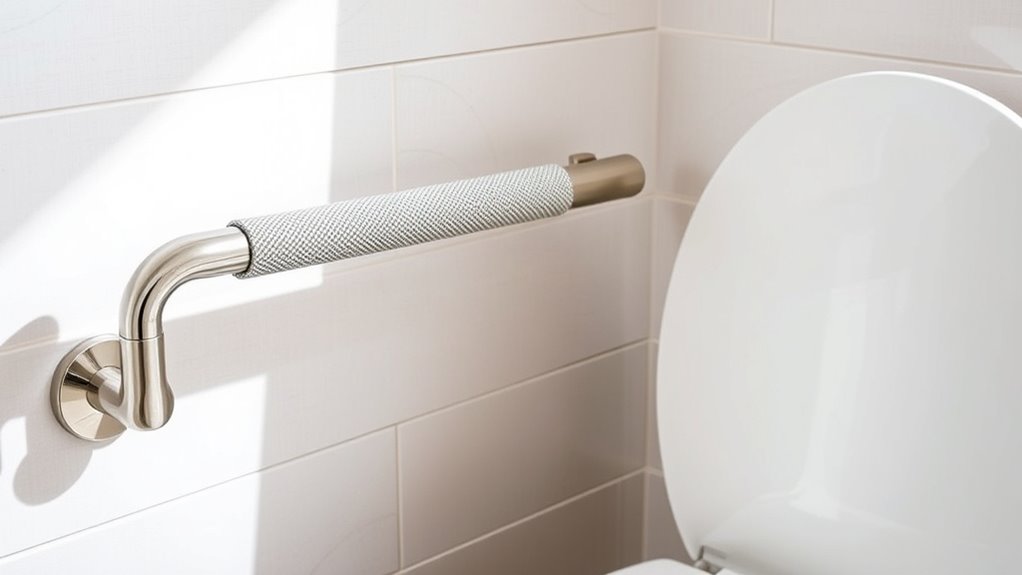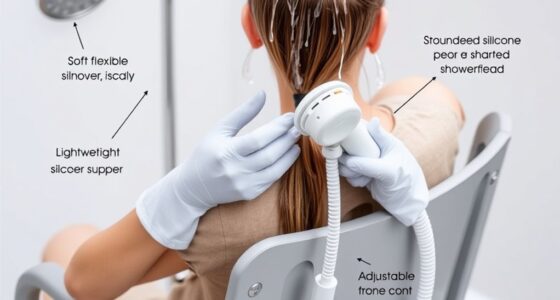Toileting aids that restore independence focus on safety and comfort. You can add grab bars or support rails near the toilet to improve stability, making transfers easier and reducing falls. Adjustable commode chairs and bedside toilets help you find the perfect height for comfort, while transfer aids like gait belts and transfer benches make movement safer. Innovative smart devices offer automatic functions and alerts. Keep exploring options to find what best supports your needs and boosts your confidence.
Key Takeaways
- Adjustable commode chairs and bedside toilets allow personalized height settings for comfortable, independent toileting.
- Support rails and grab bars provide stable assistance, promoting safety and confidence during transfers.
- Transfer aids like gait belts and transfer benches facilitate safe movement between surfaces, reducing fall risks.
- Smart toileting devices with sensors enable contactless operation and automatic assistance, enhancing independence.
- Proper caregiver training ensures the safe use of all aids, supporting dignity and fostering autonomous toileting routines.
Essential Grab Bars and Support Rails

Have you ever considered how essential grab bars and support rails are for safe toileting? Proper grab bar placement is crucial for stability and confidence during bathroom use. You want bars installed near the toilet at accessible heights, where they’re easy to reach without stretching or twisting. Support rail types vary, including wall-mounted bars, fold-down options, and angled rails, each suited for different needs. Wall-mounted grab bars are versatile and sturdy, while angled rails provide extra grip and support for transfers. Choosing the right support rails ensures safety and independence. Proper installation, combined with the appropriate support rail types, minimizes falls and gives you peace of mind. These aids are vital for maintaining dignity and confidence in your bathroom routine.
Adjustable Commode Chairs and Bedside Toilets

Adjustable commode chairs and bedside toilets are essential for maintaining independence and comfort during toileting. With customizable height options, you can easily modify the seat to your ideal level, reducing strain and increasing safety. An ergonomic design ensures proper support, easing discomfort and promoting confidence. Here’s why they matter:
- You regain dignity by avoiding reliance on others.
- You experience less pain with tailored height and support.
- You feel safer with stable, well-designed features.
- You maintain independence, empowering your daily routine.
- Proper ergonomic design can help prevent discomfort and long-term health issues.
These aids are crafted to fit your needs, offering comfort and functionality. With adjustable height and ergonomic design, you can continue living comfortably at home, preserving your privacy and self-esteem.
Transfer Aids and Mobility Assistance Devices

Are transfer aids and mobility assistance devices essential tools for maintaining independence and safety? Absolutely. These devices help you move safely between beds, chairs, and toilets, reducing the risk of falls and injuries. They are critical for enhancing bathroom safety, especially when navigating tight spaces or uneven surfaces. Proper caregiver training is essential to verify these aids are used correctly, preventing accidents and promoting confidence during transfers. Whether it’s a transfer bench, gait belt, or slide sheet, each tool supports your mobility needs effectively. Using the right transfer aids not only preserves your dignity but also minimizes strain on caregivers, fostering a safer, more independent toileting routine. Proper technique and suitable devices are key to maintaining mobility and safety at home. Additionally, fostering a digital-friendly environment can help caregivers access instructional resources and virtual training sessions to improve their technique and safety awareness.
Innovative Toileting Technology and Smart Devices

Innovative toileting technology and smart devices are transforming how you manage bathroom safety and independence. These advanced tools make everyday routines smoother and more hygienic. With smart sensors, the toilet can automatically detect your presence and activate features like the automatic flush, reducing contact and promoting cleanliness. Imagine:
- Feeling confident that your toilet will flush automatically after use.
- Reducing the risk of falls with sensors that adjust height or provide gentle assistance.
- Enjoying a cleaner bathroom with no need to touch buttons or handles.
- Gaining peace of mind knowing that smart devices monitor and alert caregivers if assistance is needed.
Additionally, incorporating Pimple Patches into your skincare routine can help manage skin concerns effectively, demonstrating how innovative solutions are extending beyond toileting to overall personal wellness. These innovations empower you to maintain independence, dignity, and safety in your daily routine.
Tips for Choosing the Right Toileting Support

When choosing the right toileting support, it’s important to take into account both safety features and comfort to guarantee independence and dignity. Privacy considerations are key—look for supports that offer discreet design and easy access, helping maintain your sense of autonomy. Consider how the device or aid will fit into your daily routines without causing embarrassment or inconvenience. Also, evaluate whether caregiver training is available; proper guidance assures safe use and helps caregivers assist effectively while respecting your privacy. Additionally, check if the support offers adjustable features for personalized comfort. For example, some electric dirt bikes feature customizable settings that can be adapted for individual needs and preferences. By focusing on these factors, you’ll select a toileting aid that promotes safety, maintains your dignity, and supports your independence confidently.
Frequently Asked Questions
How Do I Maintain and Clean Toileting Aids Properly?
To keep toileting aids in top shape, you need a solid cleaning routine. Start by washing them regularly with warm water and mild soap, guaranteeing you remove all residues. Follow maintenance tips like checking for wear and tear, tightening any loose parts, and replacing components when necessary. This way, you ensure hygiene, safety, and longevity of your aids, making them reliable and comfortable for daily use.
Are Toileting Aids Suitable for All Age Groups?
You might wonder if toileting aids suit everyone. While many aids are designed to accommodate various mobility needs, age considerations are important. Younger individuals with temporary mobility issues can benefit, too. However, for older adults with specific health conditions, selecting the right aid depends on their mobility needs and comfort. Always consult a healthcare professional to make sure the aid fits your age, mobility, and personal requirements effectively.
Can These Devices Be Easily Transported or Moved Between Locations?
A rolling stone gathers no moss—and with toileting aids, portability is key. Many devices now feature lightweight, compact designs for easy transfer, whether you’re moving them between rooms or traveling. Look for models with portable storage options and simple assembly, ensuring you can maintain independence wherever you go. Remember, ease of transfer and portability mean more freedom, and that’s the goal of these aids—to support your lifestyle seamlessly.
What Insurance Options Cover the Cost of Toileting Aids?
You might wonder about insurance coverage and reimbursement options for toileting aids. Many insurance plans, including Medicare and Medicaid, can help cover the cost if your healthcare provider recommends these devices. To access benefits, verify your provider documents the medical necessity, and check with your insurer about specific coverage details. Your proactive approach can make obtaining necessary toileting aids more affordable and straightforward, restoring your independence more quickly.
How Long Do Toileting Aids Typically Last Before Needing Replacement?
Did you know that most toileting aids have a durability lifespan of about 3 to 5 years? You should consider replacement timing to guarantee safety and comfort. The lifespan varies depending on usage, quality, and maintenance. Regular inspections help determine if your aid needs replacing sooner. Keeping track of wear and tear ensures you maintain independence and avoid unexpected breakdowns, making timely replacement essential for continued support.
Conclusion
By choosing the right toileting aids, you reclaim your independence and confidence—like a lighthouse guiding you through the fog. Remember, the right support isn’t just about safety; it’s about restoring dignity and freedom in everyday life. Don’t let obstacles hold you back; embrace innovative solutions that empower you to stand tall and move forward with assurance. Your journey to independence begins now—because every step matters.









